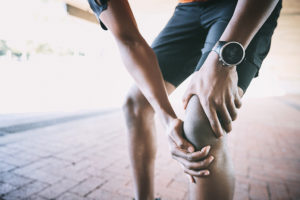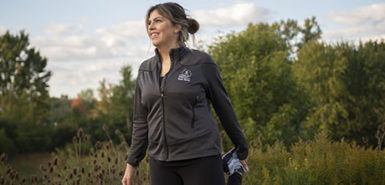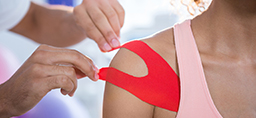
For many athletes, arthritis is a dreaded diagnosis.
Will their doctor tell them to stop exercising? Will they have to give up their favorite activities?
“I have had patients avoid the doctor’s office for years, fearing that they would be diagnosed with arthritis,” said Matthew Axtman, DO, a sports medicine specialist with Spectrum Health Medical Group Orthopedics.
“However, being diagnosed with arthritis is not an endgame to exercise.”
There are many effective ways to manage arthritis to keep you in the game—but that list does not include denial and avoiding the doctor’s office.
Rather, getting diagnosed early boosts your chance of treating it and preventing symptoms from getting worse. And you will be more likely to maintain your active lifestyle, said Dr. Axtman, the lead physician for the 2021 Amway River Bank Run.
Dr. Axtman described how arthritis occurs, how to prevent or minimize your risk for it, and how to manage it.
Arthritis involves a painful and inflamed joint—anywhere in the body.
Sports-minded folks often are most concerned about osteoarthritis.
The most common form of arthritis, it occurs with the wearing down of the cartilage of the joints.
This cartilage provides a porcelain-like covering over the bone at the joint. Like tire treads on a car, it provides protection and cushioning and allows for smooth movement.
When osteoarthritis occurs, it can cause joint pain, swelling, stiffness, loss of motion, a grinding sensation, clicking, popping, instability and a locking sensation.
Osteoarthritis most commonly occurs in the knees, hips, hands and shoulders.
Causes
A number of factors can contribute to your risk of having osteoarthritis:
Age. This is the most common reason for osteoarthritis and one that you cannot control, Dr. Axtman said. As your body wears down over time, so does the cartilage on your joints. By age 70, the majority of the population has some level of osteoarthritis in their joints.
Genetics. Researchers have discovered genes that can make you more susceptible to osteoarthritis. That’s why those who are diagnosed often find their parents or siblings also have dealt with osteoarthritis.
Weight. Excess weight puts increased force on the joints.
“Every excess pound is 3 to 5 pounds of extra force through each knee,” Dr. Axtman said. “So if someone is 10 pounds overweight, this translates into 30 to 50 pounds of additional force through each knee.”
Maintaining a healthy weight can help prevent the destruction of cartilage.
And if you are overweight, losing weight can ease pain in your joints.
Gender. Until age 55, men and women experience the same rate of osteoarthritis. But after age 55, the rates rise in women.
Does running cause osteoarthritis?
“There is a significant amount of research into exercise and osteoarthrosis and there is some disagreement on this topic, but most medical professionals believe that there is not significant direct correlation between running and osteoarthritis,” Dr. Axtman said.
But there are some caveats.
“In a perfect world, a normal-weight runner who is light on their feet and has a perfect running gait and ideal foot strike has minimal chance of developing osteoarthritis,” he said.
However, an athlete carrying some extra pounds may put more force on the knee, which can cause degenerative changes of the cartilage.
Also, an abnormal running gait or heavy foot strike also can cause abnormal forces in specific areas of the knee, causing abnormal wearing of the cartilage.
And if osteoarthritis is already present, running can wear down the cartilage and increase pain.
Treatments
Osteoarthritis can’t be cured, Dr. Axtman said. Once the degenerative changes have started, they cannot be reversed.
However, he listed a number of options to treat the symptoms:
Exercise. This is one of the most beneficial treatments. Exercise helps lubricate the joint and stimulate blood flow, which may ease arthritic pain.
Low-impact exercise in particular has been shown to decrease arthritis pain. That includes walking, biking, swimming and working out on an elliptical machine.
“This does not mean you cannot run if you have osteoarthritis,” Dr Axtman said. “But modifications may be needed if pain develops and the osteoarthritis progresses.
“Your physician may recommend decreased speed and distance as well as cross-training.”
Physical therapy. Strengthening muscles and addressing joint mobility can help stabilize an affected joint and decrease pain.
“Think of your physical therapist as an automotive technician,” Dr. Axtman said.
“If you have a car that is out of alignment, which causes the tires to wear abnormally, the technician can balance out the car to prevent further damage.
“Similarly, if you have muscle imbalances or abnormal exercise and gait patterns, a physical therapist can normalize function and decrease pain.”
Anti-inflammatory medications. When using these medications—such as ibuprofen, naproxen and acetaminophen—to address pain, be sure to monitor intake. Long-term use may cause stomach issues.
Dr. Axtman advised discussing the use of these medications with your physician to prevent interactions with other medications.
Ice and heat. These may provide temporary relief only. They typically do not penetrate the joint to get directly to the cause of the pain.
Bracing. A brace can be used for daily activities as well as exercise. It can help by providing support and keeping the joint stable.
Injections. A steroid or cortisone injection is the most potent anti-inflammatory and it helps to decrease the inflammation that stems from worn-down cartilage.
Another injection is viscosupplementation, also known as the “lubricating shot” or the “rooster injection” because it was developed using the comb of a rooster.
“It is like an oil change for your knee joint,” Dr. Axtman said. “Very viscous fluid is injected into the knee joint to coat and lubricate it and decrease inflammation.”
Orthobiologics. These are specialized injections that use the patient’s own body tissues to address pain. Two of the most common orthobiologics are platelet-rich plasma and stem cell injections. These have been beneficial in addressing pain that stems from osteoarthritis, although they do not cure the degenerative changes or reverse the damage that has been done.
Surgery. Surgery could include an arthroscopic intervention to “clean up” irregularities in the cartilage. There is also the option of replacing the knee joint if the pain is uncontrolled and there is a severe case of osteoarthritis.
“No one wants osteoarthritis,” Dr. Axtman said. “But a diagnosis is not the end of exercise, so do not let it come between you and the activities that you enjoy.”
 /a>
/a>
 /a>
/a>
 /a>
/a>